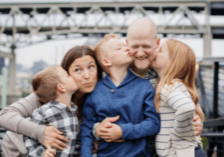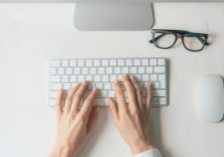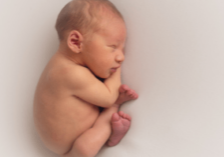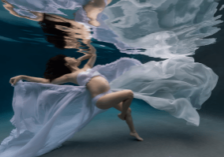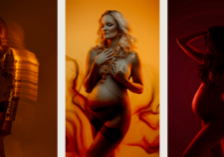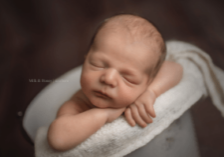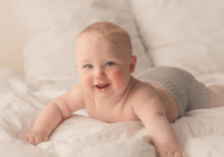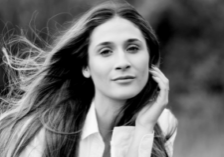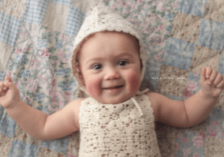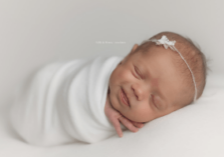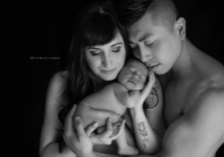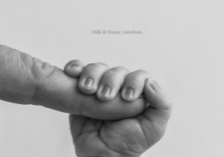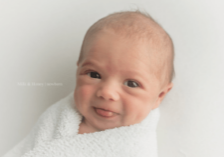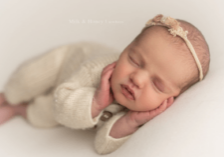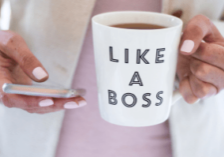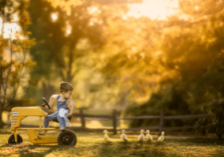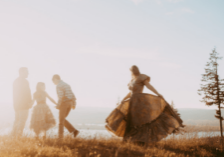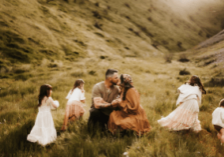Expertly-Crafted Experiences and Top-Tier Service: How to Build a Luxury Photography Brand with Lindsay Walden
Have you ever caught yourself thinking, “I wish I could have a luxury brand, but…”
Well today, Lindsay Walden is here to address those “but”s. Because you’re probably not lacking talent or clientele or even location, the first thing you need to address is your trepidation. When it comes to luxury, confidence and willingness to step into the space in the first place is what keeps most photographers on the outside.
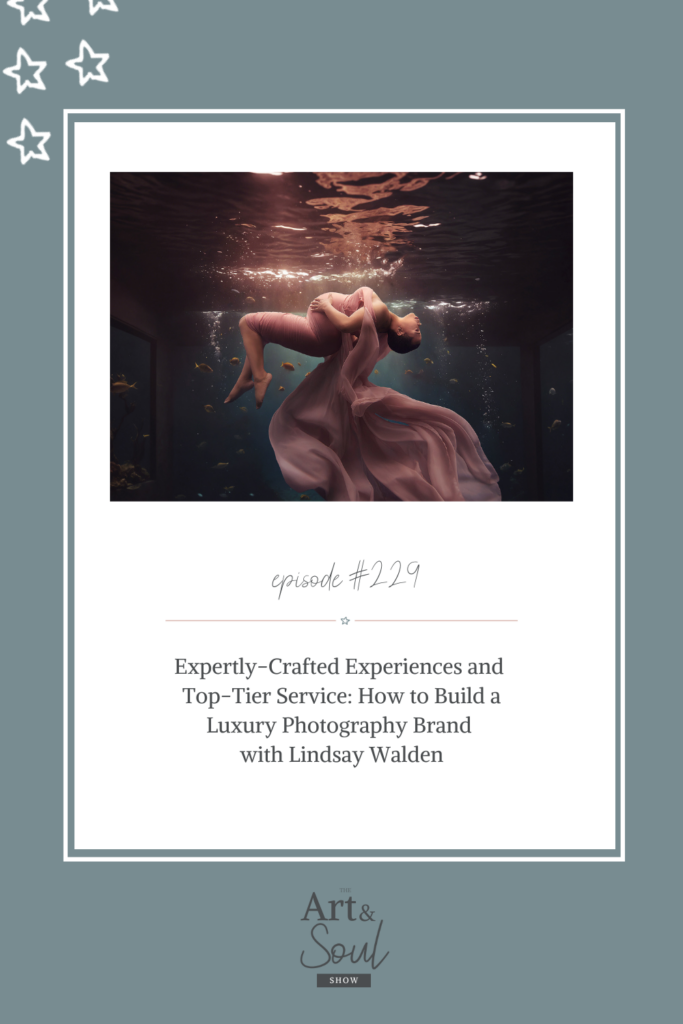
In this episode, Lisa chats with Lindsay all about her workflow for luxury clients, how she structures her sales, and why positioning in the luxury market matters as much (if not more) than anything else. We also dive deep into the money hang-ups that keep many women from even attempting to break into the luxury photography space.
If you’ve been trying to establish a luxury brand, but are struggling to find clients, this is the episode you need. Let’s dive in!
What’s in this episode:
- [02:21] How Lindsay went from snapping scenes underwater to maternity photography and how the photography landscape has changed during her career
- [06:37] What a luxury photography experience looks like with Lindsay (and why she focuses on digital image sales)
- [11:14] The key elements you need to cultivate a luxury photography brand
- [17:25] How Lindsay tailors each session to her clients
- [22:12] How Lindsay structures her pricing to expenditures like props, wardrobe, etc
- [25:17] Pricing mistakes that photographers make over and over
- [34:57] The fears photographers make up for themselves (ie. luxury clients are harder to work with)
- [40:10] The market doesn’t care and how that can be freeing for photographers
Tune in to this episode for the encouragement you need to start cultivating your luxury photography brand!
SUBSCRIBE: Apple Podcasts | Spotify
Want to put an end to awkward moments in your photo sessions and create genuine connection? Download The Storyteller’s Toolkit today, featuring 200+ emotive photography prompts, so you’re never left wondering what to say.
Meet Lindsay Walden
Lindsay is a maternity and newborn photographer based in the Dallas/Fort Worth area of Texas. Her passion lies in crafting exquisite art pieces that capture a client’s unique story while also providing them with an effortless and delightful experience. Every session is a curated journey—designed with meticulous attention to detail, tailored to the client’s vision, and brought to life with creativity and elegance. For over a decade, Lindsay has been an educator in the industry, passionate about helping photographers build their dream studios and achieve their financial goals by teaching them how to price, brand, and market to luxury clients.
Lindsay has been a keynote speaker for Belly Baby and Beyond, and instructor for the Maternity and Newborn Summit and PPA events. Her work has been featured around the world in The Wall Street Journal, CW33, Merit Street News, People Magazine South America and more.
Meet Lindsay
Visit Lindsay’s photography website
Did this episode help you rethink the way you think about finding success in your business? Check out this episode Defining Success and Setting Goals for Your Business (and Yourself!) with Jai Long that shares how another photographer started their career!
Transcript
[00:00:00] Lindsay: If you go into a really high end jeweler, say, they’re not going to have prices up. You’ll come in and they’ll find out what your need is. How can they fill that need? Who are you shopping for? What is it that you’re looking for? And then they show you some options. You pick out what you love and no, no price is even talked about oftentimes.
[00:00:18] So you’re not focusing on pricing. So you’re not talking about discounts. You’re focused on showing them the experience. And you’re focused on alleviating pain points. So showing like that I offer hair and makeup, that I offer wardrobe, that I’m being mindful about what is it that she could be worried about, that I want to address up front.
[00:00:37] Those kinds of things are what a luxury client is looking for.
[00:00:45] Lisa: Hey friend, welcome to the Art and Soul Show. I’m your host Lisa DeJeso, a mom, a photographer, and entrepreneur. Tune in here for pep talks, conversations, and advice on photography, creativity, mindset, business, life, and that [00:01:00] messy in between. This is the place where you can go when you need a boost of encouragement, a kick in the pants, and inspiration to pick up your camera.
[00:01:07] This is the Art and Soul Show. Hello, my beautiful friends. Welcome back to the show today. I am hanging out with Lindsay Walton. Now, Lindsay is a talented maternity and newborn photographer based in Dallas Fort Worth area. She’s all about creating stunning, one of a kind images that tell every client’s unique story while making the entire process feel effortless and enjoyable.
[00:01:31] Every session she does is. Thoughtfully designed with a focus on bringing her client’s vision to life in a creative and elegant way. For over 10 years, Lindsay has been sharing her knowledge with other photographers, helping them build their dream studios and reach their financial goals by teaching them how to price, brand, and market.
[00:01:48] to high end luxury clients. She’s been a keynote speaker at major events like Belly Baby and Beyond and the Maternity and Newborn Summit, and her work has been featured in publications around the world, including the [00:02:00] Wall Street Journal, People Magazine, South America, and more. I’ve been so excited to have this conversation with her.
[00:02:05] I think I’ve been following her for years, and I’m so excited we can finally connect. So welcome, Lindsay. Thank you. I am so excited to be here. So tell us a little bit about your journey into maternity and newborn photography and really what inspired you to specialize in this field.
[00:02:21] Lindsay: Absolutely. So I grew up in a home where my mom had a photography studio.
[00:02:26] It was really more of a hobby for her, but it was so fun. I remember. vividly being in the laundry room with her, the lights turned off and then that red light for she used it as a dark room
[00:02:37] Lisa: and
[00:02:38] Lindsay: just watching the magic of an image of here on the paper, the smells of the chemicals, all that is still a really vivid memory.
[00:02:44] So I’ve always loved photography. I really started my photography journey as an underwater photographer, photographing fish, sharks, like if they would pay me, I would have stayed in that genre forever because it was a lot of fun. It was when my daughter [00:03:00] was born. She’s turning 16. So this was about 16 years ago.
[00:03:03] I had a friend who said, Hey, do you mind if I use your baby as a model for newborn pictures? And I’d never heard of newborn photographs. I had no idea what she was talking about. I hadn’t seen any examples. It was really kind of invented around that time period, I want to say. So she had me bring my baby over.
[00:03:23] She’d never done it before. Those images still are just so precious to me. It’s funny because this particular friend, that was the one and only newborn shoot she ever did. She decided that’s not what she wanted to do. And I was so inspired. I just remember thinking this is something that I would really enjoy photographing.
[00:03:42] So I kind of started my Photography journey at that point, just by wanting to photograph my own children, got better equipment and that organically grew as friends saw those pictures, asked for me to take pictures of their kids and then friends of friends. And then it grew from there. I really [00:04:00] then. So I kind of nitched back down to just focusing on newborn maternity for the most part, probably about three years into business when I started photographing weddings and doing whatever anybody wanted me to do.
[00:04:12] About the same time I decided I wanted to be more luxury and decided that I wanted to niche down and really focus on the things that I loved most.
[00:04:19] Lisa: I love that. We’ve such a similar story because I started in 2010. My son will be 50 actually just turned 15. So he’ll be 16 next year. But I would like the same time, like there was nobody doing newborn photography.
[00:04:32] It was really like Tracy and Kelly and Baby is Art and like, and Gettys. Like that was it. Yeah. And like, I remember just combing the webs. I think this was even before Pinterest and just trying to like, find some inspiration on how to do it because we were all like, Flying blind back then. Oh for sure, right?
[00:04:54] Lindsay: It’s kind of embarrassing honestly to go back and look at
[00:04:57] Lisa: those pictures.
[00:04:58] Lindsay: Those are like, they’re printed on
[00:04:59] Lisa: [00:05:00] CDs So
[00:05:00] Lindsay: nobody ever has
[00:05:01] Lisa: to see them. I’ve seen them and it’s funny cuz I look at them and I was like Oh girl, you thought you could pose and I was like that wasn’t posing lovey like you You spent hours trying to make that, but that’s not a
[00:05:12] Lindsay: pose.
[00:05:13] Yeah. It’s really embarrassing. I do share those images sometimes with my students because that question always comes up. How do I know when I’m good enough? Kind of thing. And I’ll show like where I started, where I was at when I raised my prices, which really wasn’t all that great. Yeah. Much different.
[00:05:29] But I thought I was amazing. I know. The little, I learned how to crochet, so I could make those silly little owl hats. Oh my God.
[00:05:39] Lisa: Oh, the memories. Oh, I know. Seriously, the pictures. Oh, I have some of the worst hats, like made with that, that loom knitter. Cause like, Oh yeah. I like, Yeah. They are so bad and so funny and, but I love them because we all have such a similar journey from when we started.
[00:05:55] And you know, I just love that so much.
[00:05:58] Lindsay: I love where the [00:06:00] industry has gone, how much better we’ve all gotten, but also the fact that we’re not all the same anymore. Yeah. Like, we’re, we’re, everybody’s just different.
[00:06:08] Lisa: And I agree. And that there have become some standards when it comes to safety. Yeah. That were not there in the beginning.
[00:06:16] Like I remember seeing images on Pinterest of babies in glass and like just things that you’re like, Oh my gosh, that’s so dangerous. Or even like the whole suspended baby, like we’ve been through a lot in this industry and now it’s finally like, Like, you’re, as a teacher and myself, like, safety is like our number one priority with these little ones.
[00:06:37] Yeah. love that. So I want to talk about luxury experience because that is your jam and your sessions really are curated as journeys. So can you maybe walk through your process, how you design a session for your clients? Absolutely. Absolutely. So
[00:06:53] Lindsay: I
[00:06:53] Lisa: always.
[00:06:54] Lindsay: Meet with my clients before I even book them. So I do what’s considered a complimentary design [00:07:00] consultation for every inquiry who they ultimately will get on the phone with me first to make sure that they are a good fit.
[00:07:07] And then I invite them to come in and meet with me in person. During that design consultation, I just learn as much as I can about them. I love getting to know my clients, what’s important to them, the things they love, what their style is like. And then I use that as inspiration to design my sessions. So they’re all unique.
[00:07:24] Sometimes I’ll have clients that come in and say, you know, I love everything that you do. Yeah. Like we trust you do what you want, but even then I’ll make sure that I’m finding out, well, what colors do you love? I get those occasional clients that are like, literally, I love everything. I’m like, okay, well just tell me what you don’t like.
[00:07:38] Yeah, because I want to make sure that what I’m creating is something. I’m pretty sure 98 percent sure that you’re going to love every image I create no matter what, but I really want them to feel invested in the experience itself. So it feels more collaborative to them. Now, ultimately I’m the artist, so I’m making all the design decisions, but they’re [00:08:00] trusting me with that.
[00:08:00] So I really use them as inspiration, whether it’s a theme or if it’s just a particular style they really love. When I say that, I have my own aesthetic that I think I stay true to. So when I’m not switching my style from one to the other, I have a very distinct aesthetic that I will always stick to, which is really just classic and clean when it comes to editing styles.
[00:08:24] So that just makes it easier where then the sky’s the limit, depending on maybe their profession or their culture. We use that as inspiration. And then from whatever that the things that they love, we’ll pick colors that make sense for that, that they really like. So it’s a very collaborative journey and it’s just so much fun because it’s different every time.
[00:08:44] Lisa: Yep. I love that. Now, are you IPS? So you do in person sales? I love that. Awesome. So do they come back for an ordering session later or can you do that virtually?
[00:08:54] Lindsay: Yeah, absolutely. All my clients typically will come in person. I do have clients that come from out of state. If they’re [00:09:00] coming from more than like two hours away.
[00:09:02] I will offer, uh, to do it via Zoom, but even if they’re an hour, 90 minutes, even if they’re coming from out of state, I still offer the in person reveal session and I explain to them why there are advantages to that of being there in person with me. So I’ve had clients who will Um, and then I will fly back for that as well, but I will offer it as a zoom consultation occasionally.
[00:09:25] If it’s a major hardship for them to be able to come back for that.
[00:09:29] Lisa: I love that. So as a luxury brand photographer, what would you say would be the most popular items that you’re selling to clients currently? This is going to sound kind of weird, but digital
[00:09:38] Lindsay: images. That’s, that’s my bread and butter that that’s what I create.
[00:09:43] So I really focused on selling the digital images. Awesome.
[00:09:46] Lisa: Awesome.
[00:09:47] Lindsay: All of my clients will come away from a session with the digital images that they’re picking out. And then those same images they pick out, I’ll print for them either in an album or in a portfolio box. So those would be my top [00:10:00] two other big sellers.
[00:10:00] I’d say albums are more popular than the boxes, but I like to offer both. And then beyond that, I offer all kinds of different wall art, the classics. The more modern like metals and acrylics have been popular for wall art pieces, but really digital images. That’s what I primarily am selling. And that’s where the majority of my incomes come from.
[00:10:20] Yeah. I love that. And I love that
[00:10:21] Lisa: you, like, you’re pricing yourself in a way that, that feels good because you know, there’s been that whole history of like digital files being incredibly discounted or very, very inexpensive and people being called student burners and all these different labels that they have.
[00:10:36] So I love that you can be a luxury photographer with a luxury brand, but still being able to provide digital files. I love that.
[00:10:42] Lindsay: Absolutely. A lot of people mistake in person sales as selling product or physical product. Yeah. I think that you can absolutely sell digital images. Just do it in person. Yeah.
[00:10:55] And it will enhance your sales. It will enhance the level of service you’re [00:11:00] providing your clients.
[00:11:01] Lisa: Um, and
[00:11:01] Lindsay: so I do love wall art, like there is nothing better than seeing your images beautiful blown up in your client’s home. But my, my model really emphasizes the digital images cause that’s what I created and that’s what matters the most to
[00:11:14] Lisa: me.
[00:11:14] Love that. Now you focus on providing a luxury client experience. So what would you say are the key elements that really define a luxury photography brand?
[00:11:25] Lindsay: I think as a brand, I’m going to emphasize what I always emphasize first with my students. You cannot be a luxury brand with low prices. Yeah. So your pricing is part of your luxury brand.
[00:11:37] It’s just very confusing to clients if you’re trying to sell yourself as a luxury experience, but it’s a 15 minute mini because that really isn’t luxurious to anybody. Yeah. It’s a lot of stress. Being a luxury brand, you’re focusing on the experience for your client and making sure that it’s just seamless and easy.
[00:11:58] So I go through and just really [00:12:00] am mindful of what are potential pain points that a client might experience before, during and after a session and make sure that those are addressed in advance. And then have every conceivable thing that could potentially go wrong, that they might forget all of those kinds of things, just have it ready.
[00:12:18] So it takes a lot of mindful brainstorming to make sure that I’m prepared so that when my clients arrive, that they feel well prepared because I’ve done that consultation with them. And then if they forget something, we probably have it, and it’s not going to be a big problem. And then we also provide so much so that it’s just easy and fun for them.
[00:12:36] So really the goal is make it easy for them. The shoot should be, um, everything that they might be worried about as far as like their appearance. Like we offer hair and makeup. We have wardrobe for the whole family basically except for dads. So we just really try to make it so fun and easy so moms don’t feel stressed out about it.
[00:12:55] Lisa: Yeah. I love that. So a lot of the times we hear from our students. [00:13:00] My clients will not pay that and they want to be a luxury brand, but they’re stuck at this sort of spot where they’re really struggling to get clients that will pay the rates that they need to make to have a sustainable or profitable business.
[00:13:12] So they’re in this kind of just funny spot where they don’t have any clients, but they have this desire to be this luxury brand. So with your coaching clients, what would you suggest in this scenario? Well, you, You kind of said two
[00:13:24] Lindsay: different things. If they, they say my clients won’t pay that, that means that they already have some clients, right?
[00:13:29] Yes. And here’s the thing. When I switched my pricing, I went from charging 250 and they got a CD. Yeah. Really cute with like a sticker on it of all of their edited images. And overnight I switched to charging 250 for just a booking fee. And then my collections were starting over a thousand dollars. So literally over a night, like, I lost every client that I had at that 2.
[00:13:56] 50 rate. Not one of them saw the value in going [00:14:00] up to the 1, 000 rate, but I actually, my business soared. And now this was probably unique to me in that I was one of probably only a handful of clients. If any, I only knew of a couple other newborn photographers in my area that were going luxury at the time that I did.
[00:14:15] So being first in your area is like really, really nice because they didn’t even have to market. It was just people inquired, they heard the price and they were like, yes, we want to book with you. I had a really, Great experience with one of the first people who booked with me came in for her consultation.
[00:14:31] She, we went over the pricing, my top collection at the time I think was 3, 200. She told me, Oh yeah, we’ll probably get that collection. And I remember telling her, Oh yeah, that one’s really popular. Like I literally had never had a client come in for a reveal session yet. And before she left, she gives me a hug and she says, I knew you’d be good because you’re expensive.
[00:14:51] And it was hard for me because in that moment I was like, I’m like not any better than I was. The week before when I was only 250, but that psychology of [00:15:00] my pricing
[00:15:01] Lisa: really
[00:15:01] Lindsay: had an impact on who would book with me. So a lot of people say, well, I haven’t, I struggle to book clients at these prices. How will I book them at higher prices?
[00:15:11] And it could be that you’re struggling to book them because you’re too low. You are not attracting the luxury client. They’re saying no, you assume they’re saying no because you, you think it’s an issue with price and it is, it’s that you’re too low. So that is a really hard mindset to change. I still, it’s still a struggle.
[00:15:30] Everyone’s still on things, you know, maybe aren’t as, as busy as they want them to be. I’m like, Hmm, maybe I should lower my prices. And I’ve just trained myself. No, anytime I feel that I probably need to raise if anything, or I just need to spend more time on mark. So it does require more marketing. You can’t just now that I have so much more competition, which I’m happy to report that most of my closest friends in the area and DFW area are my competition.
[00:15:54] Or my students that I’ve trained literally in the area. And I love that. Like we’ve elevated the market so [00:16:00] much and found that there are so many people that are looking for that luxury experience, especially for newborn, because they really want to feel taken care of in that moment in their life.
[00:16:11] Lisa: I love that.
[00:16:12] It’s so true. And I think I love that you embrace the community over competition because I think that is so important. I think it was funny because I remember in the beginning days of starting out as a photographer, it wasn’t overly welcoming. And that was one thing that really bothered me that. And so that’s always what I’ve tried to do when we’ve got, when I’ve got local students is that how many, how many babies do I want and how many babies are born in the city?
[00:16:35] Like there’s enough babies for everybody, like everybody can win here. So let’s just stop stressing out about what everyone else is doing.
[00:16:42] Lindsay: Yeah,
[00:16:43] Lisa: I really, if I just focus on what
[00:16:45] Lindsay: I’m doing, I do love like getting together with my photographer friends and having lunch and like, what have you been up to? And hearing like, The things that they’re doing, but the one other thing is as a luxury brand, we are very much our brand.
[00:16:58] Like that’s the [00:17:00] unique thing about being a business that is centered on an individual is that our uniqueness makes our business unique. So whether it’s small differences in our styles, small differences in the way that we approach and treat our clients, none of us is going to be the same. And so one client might be more drawn to.
[00:17:19] Web particular photographer than they would be another. And I just love that about it. I think it’s great.
[00:17:25] Lisa: Yeah, I teach you. All right. So how do you tailor each session to match the unique story and vision of your clients? So I have a workflow that
[00:17:36] Lindsay: I pretty much capture to me the same images for every client in that I’m getting particular angles of every setup.
[00:17:44] I’m getting macro shots from particular setups. I’m doing prop shots and then I’m going to the bean bag and getting texture and monochromatic images. So every session is the same, but every session is different. Does that make sense? Yeah. [00:18:00] So I have this, a very similar workflow for every session, but it’s also customized to the client.
[00:18:05] So the colors that they’re picking out, the particular themes that they’re picking out, it really looks different every time. And then as I. I have been doing this, especially doing in person sales. It’s helped me to learn what sells well and to learn what to focus on. So there was a time where I was really stressing because I was not good at like taco.
[00:18:28] Pose and froggy. I’m like hit or miss and bum up. Sometimes it looks great. Other times I’m like, I don’t know what I’m doing. And I was like, I just really got down on myself. But what’s interesting is my clients really will only buy one of those poses. Maybe two. That’s not what they’re coming to me for.
[00:18:45] They love the more designed prop shots and they love the family images. So doing in person sales really helped me to, to understand that those family images and the mom shots in particular, and sibling images. If I emphasize [00:19:00] those and find ways to make those unique and beautiful, I’m going to make a lot more money, which ultimately like that’s.
[00:19:06] Lisa: That’s what we want, right? Exactly. When I started adding awake baby images with those like funny, when you get the hilarious images and like make it into a little like collage or that was like game changer because I used to always hand the baby back and I’d wait for baby to fall asleep. But then when I started shooting those in between moments and like the yawns and all those things, it really, like those are the ones my clients always posted them and they love, right?
[00:19:35] Lindsay: Eyes open and smiles. They’ll buy every single time. Oh,
[00:19:38] Lisa: yes. Smiles. Oh, gosh. Love it. I love it. So how do you maintain creativity in sessions when you do have a workflow? I take my time with each.
[00:19:49] Lindsay: So I, I have a rule about setup. We always set up the day before. So I do my newer sessions typically in the morning and we’ll set up sometimes 24 hours in [00:20:00] advance.
[00:20:00] Yeah. Yeah. I’ll have my assistant there so that I can be like, Oh, grab me, you know, all the, the blue things in this total range. And we’re like comparing and trying to figure out. And so I have my notes from the design consultation with my client. Sometimes I’m texting them, like not necessarily to get their okays.
[00:20:19] They’re not picking out specific props and things like that or outfits. I pick all of that, but maybe they’re bringing something from home. They always. Are they required to send me a picture if they’re bringing something from home for me to use? And I want to like reference that. So really it’s just kind of like playtime where I think my assistant and I, we really enjoy that, that process of getting, um, the different things out that we think we might use.
[00:20:43] We make a giant mess as we like, we’re like, we’re going to use this and then we’re throwing stuff over in the corner and then she puts it all away before the actual session. But yeah, it’s just really just a fun creative process. It depends on what we’re doing, what the client asks. So it just feels different [00:21:00] and fun every time.
[00:21:01] Um, again, like I have a workflow where it’s, we’re doing, we always photograph baby first. Um, cause moms are almost always in hair and makeup while I’m photographing babies. So that’s really nice and convenient. It’s also then makes it a surprise when they see their images, which I love, but then we do the family images, sibling images last, the siblings don’t even have to be there until the very end.
[00:21:22] So yeah, it’s, it’s hard to describe the process cause they feel like it’s different every time. It depends on the client. It depends on what we’re doing. If they, at their consult. You know, two, three months before their due date. Let me know. Oh, like I had clients, they, they both work for Southwest airlines.
[00:21:38] So I had time to have, to reach out to a vendor and have her make me a cute little Southwest airlines outfit. Um, so if I know foreign enough in advance, I’ll have things custom made. Even if I know I’m only going to use it once, that’s totally fine. It’s, it’s worked into my cost of doing business that I might have to buy something specific for a session and not [00:22:00] personalization.
[00:22:01] Down so like the baby had a little name tag with his name on it like parents absolutely love it And they’re willing to invest for that kind of level of detail and care in their images.
[00:22:12] Lisa: I love that I think a lot of Beginning photographers and even those that have been at a few years. They forget about the building the image You’re the stuff you may need to purchase or want to purchase into your cost of doing business and it’s either spending all that money and overspending and not being profitable and not paying yourself and then Having this huge massive pile of things that you probably rarely use.
[00:22:38] It’s The spending in the industry can be a little tricky. Can you give me any advice on
[00:22:44] Lindsay: that? This really boils down to your goals for your business, the type of studio you want to be. I’m a, I had a client say this once to me and I, it just hit me that this is when you, I’m talking about my ideal client and myself, this is.[00:23:00]
[00:23:00] It is the epitome of who we are. She said, I’m, this is when she was trying to pick out gowns for her maternity session and she couldn’t narrow them down. She’s like, you know, Lindsay, I think I’m less of an or person and more of an and person. That is my woman. So I think that. Like so long as you are clear, like if you want to be a prop heavy custom design type photographer, you’re going to have to have a big budget.
[00:23:26] Like we’ll spend between 20 to 40 grand a year on gowns, on props and things like that. And I have a ton. So it’s not like I need to be going out and buying all new things every year. It’s just that I want that ability to one, stay on top of trends that I think are fun, especially gowns and to be able to customize.
[00:23:46] Not every photographer needs to do that. I have some of my favorite friends who are newborn photographers do very simple, all whites. They maybe have five, six outfits they use repeatedly. I have literally hundreds of them. And [00:24:00] some of them I may not use in a year, but I’ll use them maybe in a couple of years.
[00:24:03] I don’t know. So I have a really hard time letting go of things. So long as it is incorporated into your cost of doing business, it’s fine. You can spend as much money as you want. So long as you make sure you’re being profitable. Now, if I’m slower, I’m obviously not going out and spending 10 grand on props in a month.
[00:24:20] But over time, like that average, I know how much I want to spend.
[00:24:26] Lisa: So that is reflected in my pricing. Yeah. I love that. I think that’s when you realize that you’re actually running a business and it’s not these purchases that you’re hiding from your husband because that’s something that we hear all the time in social media groups.
[00:24:38] It’s like, it’s not really, I mean, it literally is not
[00:24:40] Lindsay: his business. Like, I love my husband, which he’s not like a partner in my business or anything because he has no interest. He has his own stuff that he does. So long as I’m bringing home a paycheck, he will never question. Why I have so many boxes because I do have everything delivered to our house because it’s just easier because you know Amazon [00:25:00] comes in the middle of the night.
[00:25:01] I know. It’s amazing. Uh, so I have everything delivered to our home and he’s always like, wow, that’s a lot of boxes. And I’m like, I know, right? Yeah. It’s, uh, so long as he really doesn’t matter. It doesn’t matter as long as you’re profitable and not really sitting down and making sure that your cost of doing business is done.
[00:25:17] Lisa: Love that. All right. So that actually brings me to pricing and talking about maybe any mistakes you might see photographers when it comes to making pricing decisions for their work. Probably two things. One is undervaluing
[00:25:32] Lindsay: your time. Yeah. A lot of photographers say they’re wanting to move into in person sales.
[00:25:38] They will focus on, okay, I’m going to figure out how much it costs me to sell an album or a print, and then just mark that up by a certain amount. And they’re not taking into account one, you really have to start with your cost of doing business and see what do I need to be averaging in order to meet my goals and be able to sustain a profitable business.
[00:25:59] And then [00:26:00] based on that cost of doing business, then create pricing that really is strategic and that reflects. Um, your budget, your costs, but also includes your time. So like a small mistake that I see a lot of people doing is they’re using the same markup for an album as they would for a canvas. Yeah.
[00:26:16] An album has multiple images, so it really needs to reflect the time you take to create all of those images versus just one image. So that’s a small pricing thing. The other thing that I would see say is if you’re looking to be in the luxury market, there is this in between ground between what I call the commodity market and the luxury market.
[00:26:35] That a lot of photographers will try to straddle for a time where they want to be. It really think it’s just money blocks. And can I tell you, you don’t find men in that zone. I mean, I haven’t. Yeah. I’ve never, I’ve talked to a lot of men in the industry and have come to me for advice on things, but they don’t have the same money blocks that women do.
[00:26:57] And I find it really interesting. It is. [00:27:00] That’s probably another topic for a whole podcast. Bottom line though, is. Our pricing really needs to be a reflection of our costs and our goals and we need to be valuing our time and our time includes like digital images. Can I tell you how triggering it is for me to hear the term just digital?
[00:27:18] Yeah. Or like a client inquires, how much is it for just digital? Just digital, yeah. Why do they say that? We taught them to say that. That came from us because we were saying, well, it’s just this much for just digital. I did it too when I was on the, the, the commodity market end of things. So really valuing those digital images and your time is so important.
[00:27:37] Being in that middle zone. Oh, that’s what we were talking about. Being in that middle zone is a really hard place to be. So my advice for anyone who is wanting to be in the luxury market is don’t try to be in the mid market. Like it’s not mid luxury. You’re just mid market, which means you’re confusing potential luxury clients who are less price sensitive.
[00:27:56] So if they see A photographer who’s pricing [00:28:00] starts at say 900 versus a photographer who’s pricing starts at 2, 900. They’re going to assume the 2, 900 photographer is better, even if they’re not. Because I’ll admit like when I first made that big jump into doing in person sales and being in the luxury market, my work was terrible, really not good.
[00:28:18] And I’ll never forget in a photography forum, photographers attacking me for my pricing and telling me, you cannot be that price that high because such and such amazing photographer, this is how much she charges and she’s a lot better than you. And you know what? They were right that she was so much better than me.
[00:28:36] She still is. Oh, I always, I get, I’ve got taught with this other photographer and she’s amazing and her work is just phenomenal. But my pricing is priced based on my cost of doing business, my goals. And I’ve been successful. I’ve since raised my pricing significantly from those early days of in person sales because I’m able to.
[00:28:55] The market lets me. So
[00:28:59] Lisa: sorry, [00:29:00] down off my soap. I love that. I think that’s so important because I do find like the middle zone, I stayed in the middle zone for ages. And I overspent, I didn’t run a profitable business, and I was really embarrassed about it. And you know, like I was fully, fully, fully booked, overbooked, but it still wasn’t working.
[00:29:20] And so finally, I think it was about 2020, I just had to like, I’m putting the brakes on everything and I need to regroup here. If I’m going to reopen, it has to be in a profitable way.
[00:29:31] Lindsay: Yeah.
[00:29:32] Lisa: It’s just a really
[00:29:33] Lindsay: hard place to be and marketing is difficult because you market the way you would to a luxury client or do you market the way you would to a commodity client.
[00:29:40] You’re just confusing things. You can still get clients. It’s just hard because it’s, you’ll have clients who expect a luxury experience, but you can’t really afford to give them that experience. Exactly.
[00:29:53] Lisa: Right. So. Yeah. It’s difficult. That’s the hard part. So in what ways is marketing to a luxury client different [00:30:00] than marketing to a commodity client?
[00:30:01] Luxury clients, you don’t focus on price.
[00:30:03] Lindsay: So like if you go into a really high end jeweler, say, they’re not going to have prices out. Yeah. You’ll come in and they’ll say, you know, they’ll find out what your need is. How can they fill that need? Who are you shopping for? What is it that you’re looking for?
[00:30:16] And then they show you some options. You pick out what you love and no, no price is even talked about often times. So you’re not focusing on pricing, so you’re not talking about discounts. You’re focused on showing them the experience and you’re focused on alleviating pain points. So showing like that I offer hair and makeup, that I offer wardrobe, that, you know, I’m being mindful about what is it that she could be worried about that I want to address up front.
[00:30:42] Um, those kinds of things are what a luxury client is looking for.
[00:30:46] Lisa: Yeah, I love that. So what is something you wish more photographers knew before diving into the luxury photography space? And I think
[00:30:55] Lindsay: probably the most important thing is what I just was talking about is don’t try to start out in the middle [00:31:00] where you just, you’re like, I know I’m really inexpensive, so I’m going to raise my pricing by like a few hundred.
[00:31:07] That puts you in that mid level market. And there, I have more students coming to me that are in that mid level market. They’re coming to me because they’re struggling. They’re like, I get occasional really good sales, but I’m not getting enough to make the business really sustainable. And because they’re getting those every once in a while, thousand to two, 3, 000 sales, they know it’s possible.
[00:31:28] And I feel like my job as a mentor really is just, okay, like we’re going to add a zero to everything, sometimes two zeros to everything and hold your hand. through this process. That’s like the biggest, hardest part is just, you have to really take that leap over into the luxury market completely and not try to just slow your way into
[00:31:50] Lisa: it.
[00:31:51] It’s really hard to try and do it that way. So because then you’ll often find those that have had a business with lower end client, you know, the [00:32:00] two 50, 300 range, they lose all those. And then they’re, they’re stuck in this spot where they’re not quite. Yeah. So when they’re in that panic, how do you talk them off the ledge?
[00:32:13] Lindsay: Yeah. I, they’re in this panic mode where they’re like, well, I’m gonna have to go back to my pricing before, which wasn’t working. They weren’t sustainable. They were going to have to quit. So I’m like, why would you go back to something that you were going to quit from anyways? Why don’t you just try, like you’ve seen, you have these clients that are willing to spend maybe more.
[00:32:30] Why don’t you try moving yourself up into that luxury market? And what’s the worst thing that’s going to happen? Like, and they always say like, well, nobody will book. And what’s really interesting is like when I’ve made changes in my pricing from those first early stage of IPS, where I was starting over a thousand to now, like my, my.
[00:32:50] Minimum clients can’t come in and get away without spending 3, 500. That’s at a minimum. And very rarely does someone spend that little, I have clients that have stayed with [00:33:00] me. Like the client I told you about at the beginning that told me, like, I knew you’d be good because you’re expensive. I just did their family pictures again, like a year ago.
[00:33:07] And so I’ve made significant price jumps of thousands of dollars in my collections while giving them even less than I was before. Yeah.
[00:33:14] Lisa: Those clients
[00:33:14] Lindsay: will still come back to me because they’re luxury clients. Whereas you make a hundred dollar raise in pricing when you’re in the few hundred dollar range, you’ll lose clients.
[00:33:25] So it’s a really interesting kind of dichotomy or the difference between a luxury client and a commodity client. Really, you just have to, the best thing is if you have either a business coach, a mentor, or a, like a mastermind group of other people who are sitting where you want to be sitting is what I always say.
[00:33:45] Like, don’t take advice from people who aren’t sitting where you want to sit. Because I got plenty of advice from people who I respected and loved that told me there’s no way this is going to work. You’re not going to find people who will spend that much money. And I love, one of those was my [00:34:00] dad, who is a very successful businessman, told me there’s no way people are going to spend that much money for just pictures.
[00:34:05] And my favorite thing over many years was to call him every time I had my next biggest sale and let him know what it was. And he like cried with me. He was so happy. He told me years later, like, it sounds like the market’s telling you to raise your prices again, Lindsay. Yeah. He eventually got on board, but yeah, it’s, it’s really, I empathize with photographers who are in that space because it’s hard, especially if you are dependent upon your income to support your family.
[00:34:35] That’s a scary place to be. I feel fortunate to have a spouse where his income is good. When my income surpassed his, that was even better. And I just let people know, like, it’s possible. It’s absolutely possible where you can go from a space of just feeling really insecure to, like, why did I not make this decision sooner?
[00:34:57] Lisa: I love it. I think there is a lot of fear, too. [00:35:00] of when you have a luxury client, they’re going to be a pain in the ass, right? And I often hear that in our groups. And so can you talk on that a little bit that maybe that’s not a fear or maybe it is, I don’t know.
[00:35:13] Lindsay: Yeah. It’s funny because we have a lot of fears that we just make up in our head.
[00:35:18] We have no evidence of it. We just make it up in our head. And that is one where the biggest It’s pain in my ass clients were the ones that were when I was only charging 250. Yep. 100 percent clients, 99 percent are the most lovely. They trust me. I’m the artist. So they’re trusting me with things. They’re not like, no, they’re, nobody’s ever asked me for raw images.
[00:35:41] So if I became a luxury photographer, except for like, Commercial type things. They’re wonderful. You’ll always have those people who maybe want more retouching than your average client who might be have extra requests that my typical client might not ask for, but here’s the [00:36:00] thing. I am priced appropriately for that level of service.
[00:36:04] So I don’t mind.
[00:36:08] Lisa: Right. I think it’s great. It’s when you’re getting paid for it, the resentment goes away. Exactly. You
[00:36:13] Lindsay: will never see me complain about a client. I’ve had those occasional clients that, just that our personalities didn’t vibe, but like that’s going to happen no matter what. Yeah. But I wouldn’t call them like difficult or, uh, it was just different personalities and that’s really fine.
[00:36:29] I would say 99 percent of my clients. Like, I would be best friends with them. They’re amazing. And they value what I do, which makes me love them
[00:36:36] Lisa: even more. 100%. 100%. I love that. All right. So, you ready for our lightning round? It’s not really lightning. It’s like slight lightning. Okay. Good. Great. I’m kind of old, so I don’t know how fast to get this.
[00:36:50] I know. I’m like, we’ll try it. These are like questions. These are just other questions. Got it. Would you rather have unlimited sushi or unlimited tacos? Tacos. [00:37:00] Tacos. Every time. With guacamole. And queso. Yeah. First thing you’d buy if you won the lottery?
[00:37:06] Lindsay: An island? Yeah.
[00:37:10] Lisa: We’d have
[00:37:10] Lindsay: a big ol party. It’d be super fun.
[00:37:13] Lisa: I love
[00:37:13] Lindsay: it. Something on your bucket list. Uh, my husband and I are both scuba divers. There’s a resort that we want to go to called Wakatobi. It is on my bucket list. We will get there someday. I love it. Amazing. It also is an island. Maybe I’d buy Wakatobi if I had one. There we go. Favorite childhood memory.
[00:37:37] I don’t know why this popped into my head, but as a kid, we would get on, like, at a big family, we’d get on either side of my parents bed, and we would play balloon volleyball over the bed. It was just like, you had to keep it from landing on the floor, and we would just laugh so hard. I still, I played that with my kids growing up.
[00:37:52] It was super fun.
[00:37:53] Lisa: I love
[00:37:54] Lindsay: that.
[00:37:55] Lisa: Favorite season of the year?
[00:37:56] Lindsay: Summer. I love the beach. [00:38:00]
[00:38:00] Lisa: First concert you ever went to? Lollapalooza
[00:38:04] Lindsay: when I was 16 and wow. Oh wow. I was very naïve. We didn’t stay for super long. There was a lot of stuff going on that I was like, oh, yeah, that was shocking.
[00:38:18] Lisa: That’s funny. Favorite TV show growing up?
[00:38:22] Lindsay: You know, we didn’t watch a ton of TV when I was a kid, but I do remember he was going to date me. I love He Man and the Masters of the Universe. Yes. Okay, good. Who’s the best? Me. Yes. And what was the girl in She Ra? She Ra.
[00:38:37] Lisa: Princess of Power. Yeah. Oh my gosh. Yeah, I would play with the, uh, my brother had the He Man and I would make them the Barbies boyfriends.
[00:38:47] Yes.
[00:38:48] Lindsay: You’re
[00:38:48] Lisa: like,
[00:38:48] Lindsay: you’re
[00:38:48] Lisa: like
[00:38:50] Lindsay: the
[00:38:50] Lisa: big muscle guys. Right? Oh my gosh. That’s so funny. Yeah. I love that show. So good. Ice cream in a cup or a cone? A
[00:38:59] Lindsay: [00:39:00] cup. I’m
[00:39:00] Lisa: weird. I don’t know why. I like cups too. I’m the same. Yeah. Do you collect anything? I have a bunch of vintage cameras. I love those.
[00:39:09] Lindsay: Really cool. Yeah.
[00:39:10] Lisa: I actually use them all the time in photo shoots.
[00:39:12] They’re really fun. That’s fun. I like that. My grandpa, actually, when he passed, he gave me all his cameras. Oh, that’s I have a bunch too. And they’re from all over the years. Yeah, my
[00:39:21] Lindsay: mom gave me My mom had a couple Hasselblad film cameras that she gave me, and they’re Awesome. I just have no idea how to use them.
[00:39:28] I love it. What makes your soul light up? Probably my family. There’s just nothing that I love more than my family and being creative. I think this job, having the opportunity to get up in the mornings, come in and be creative and also being successful. Like there’s something that like, I don’t know. I don’t know if it’s my soul that’s lighting up when I have a really big sale, but something feels really good.
[00:39:55] It’s that validation. Yes.
[00:39:58] Lisa: Yes.
[00:39:58] Lindsay: And I would relate it back to [00:40:00] my family of knowing like, ah, this is, this is helping support my family. It’s making my children’s lives better. It’s making their futures brighter. That is so important to me.
[00:40:09] Lisa: I love that.
[00:40:10] Lindsay: What has been the best piece of business advice you’ve ever been given?
[00:40:14] Gosh, I remember years ago being at a conference and Julia Keller was speaking and she said something like, the market doesn’t care. I’m pretty sure she used some expletives in there that I want to use. She’s awesome. And it was a really eye opening moment for me. What she meant was, like, individuals obviously care.
[00:40:39] Like, I would say, like, my clients, like, they, a lot of them, like, really know me well. They know my kids names. Especially clients that have been coming to me for years. Like, they’ll ask after my family. As individuals, we care about each other. But as a market, as consumers, people don’t really care. Like, they just want what they want.
[00:40:58] So, [00:41:00] sometimes we make the mistake of kind of mixing business with personal in the sense of like when we’re, even when we’re doing things like on social media where we’ll, it’s okay to be vulnerable and talk about things, but like I see a lot of photographers where they’re complaining about a client who it’s like, well, my kid was sick.
[00:41:16] And so I told my client, my kid’s sick and, and it was like, and the client was so rude about it. Like they don’t care. And it’s like, well, yeah, cause they just want what they want. Understanding that. It helps me to not feel offended or, or, um, annoyed. Like if I get a text late at night from a client, I just ignore it until the morning, I’m not going to be all beat up about it, like, uh, but I’ll answer during business hours and very professionally and I don’t know.
[00:41:42] So that really helped me to also, when it comes to my pricing, recognize like. I’m so like torn up about where I’m going to price because it’s really hard to put value on something that comes from your soul, like your creativity, but the market cares about what it cares about. It cares about [00:42:00] quality. It cares about the experience when we’re talking about a luxury client and the price doesn’t matter as much.
[00:42:04] So I need to stop focusing on that. So that was just really good advice. I love that.
[00:42:09] Lisa: That’s really good advice. I like that. What advice do you have for someone just starting out?
[00:42:14] Lindsay: Uh, I think I said it earlier, don’t listen to people who aren’t sitting where you want to sit. I mean, that’s not to say that you can’t have conversations with other people, but if you’re looking for really good advice, I would talk to people who have what you want.
[00:42:28] I remember one student who literally reached out to me, inquired about mentoring, and told me over the phone, like, I want what you have. And I saw that passion in her, like that desire to, to build something similar to what I had. And she’s, she’s absolutely succeeded it and probably surpassed me, I think, in many ways.
[00:42:47] That desire to have what someone else has, um, not in a like, like I’m envying, but a I know if you’re capable of doing that, I should be able to do it kind of thing. So [00:43:00] what can I learn from you kind of attitude that has really, I think, helped a lot of my students, especially when I’m mentoring a student who is relatively new, who recognizes that they don’t want to start off the way many of us did, which is starting off really cheap.
[00:43:14] They’re like, I want to come in offering a luxury experience. I recognize I’m newer. Is it possible? And it absolutely is. Even for a newer photographer, you’ll get a lot better, a lot quicker because you can afford to. So you have like a competitive advantage over other newer photographers who are just.
[00:43:30] Not being profitable on the beginning. Yeah, exactly. I love that.
[00:43:34] Lisa: So you’re actually coming to teach with us for the online newborn retreat in January. So you, can you share a little bit what you’re going to be instructing on? I think a
[00:43:43] Lindsay: lot
[00:43:43] Lisa: more
[00:43:44] Lindsay: about what I’ve been talking about today. My subject is really the luxury experience for newborn photography.
[00:43:50] I’ll workflow looks like for a newborn session. And really when I’m talking about my workflow, it’s not so much like. I’m not going to be showing [00:44:00] posing or anything like that, that you can find in a lot of sources. I’m going to be talking about why I do the things I do and how I make money. So everything in my workflow is designed to make sure it’s very efficiently done in a way that it maximizes the profit basically.
[00:44:16] Um, so I’m going to talk about how I do that and why I focus on the things that I focus. Um, and how that ultimately helps me to maximize my potential sales. I’ll talk a little bit about sales and pricing, not super in depth, but a little bit about that. It should be a lot of fun because obviously I’m really passionate about the topic.
[00:44:35] Lisa: I love it.
[00:44:35] Lindsay: Well, we are so excited to have you join us. Thank you. I’m excited to join.
[00:44:40] Lisa: So where can our listeners learn more from you?
[00:44:42] Lindsay: Absolutely. So I have, um, a couple of resources. I do have an in person workshop coming up in February. This is for, I’d say, not a brand new photographer. There are three days to the workshop and the way my workshop runs is a little bit different than many.
[00:44:56] First day and the second day, you can come just for one [00:45:00] day. There’s specific topics that we’re teaching. The first day is really the art side. Probably a lot of what I’m going to be talking about in this particular class, the workflow and why I do things the way I do, but they’ll also see a demo of how I do a newborn shoot as well as a maternity shoot day two is just really in depth on the business side.
[00:45:18] We go over your pricing. Not just pricing in general, but pricing for each individual. We go over marketing to the luxury client, which is, um, probably a couple hours worth of our time. Um, and then day three is for a very small mastermind group that will continue to meet regularly after the workshop. So students have the option to sign up for one day, two days, or all three days if they want.
[00:45:41] It’s really fun and it’s a very small workshop. I only offer it usually every other year. And then I also have a Facebook group. Uh, the Facebook group name is, I wrote it down because I always forget what it’s called. It’s called The Luxury Photography for Professional Photographers. Love it. It’s a mouthful.
[00:45:57] Facebook. Anybody’s [00:46:00] welcome to join it. I answer questions in there, but I don’t regularly post. Yeah. I’ll be up front. I am a photographer first. I love educating. It’s something I’m really passionate about, but my income is 95 percent going, if not more from my clients, not from photographers. Um, so I am not actively necessarily promoting my teaching very often, although I’m super excited to be doing this retreat.
[00:46:25] But I feel like I can come from a more organic place when I can be, or authentic place when I can say that most of my income does come from clients and not from teaching. So that Facebook group is a great resource. If you just have questions, when I’m available, I’ll pop in there. And then a lot of my former students are in there and they’re fabulous at answering questions as well.
[00:46:44] Oh,
[00:46:45] Lisa: I love that. That’s great. I love to end my interviews just with this last question. And it is, what are you currently curious about or artistically curious about? I’ve been
[00:46:55] Lindsay: really interested for a while in learning more about gel. [00:47:00] I have some that I’ve used in my studio. I think they’re really fun for editorial looks.
[00:47:06] And it’s something that I’m curious about using underwater, because I do underwater maternity. I feel like it would be something interesting. I, I use strobes sometimes underwater, but it’s, it’s so different from using in studios. It’s been tricky. So it’s that like, I don’t have enough practice at it. I’d like to have more practice at it.
[00:47:23] You just need to schedule some time to work on it.
[00:47:26] Lisa: I love that. That’s so cool. Well, Lindsay, thank you so much for joining me today. My pleasure. It’s been fun. Oh, my beautiful friends. I hope you have loved this conversation just as much as I have. I’m sending you so much of my light and my love today and every single day.
[00:47:44] We will see you next time.
share the love
[Sassy_Social_Share]
recent
Podcasts
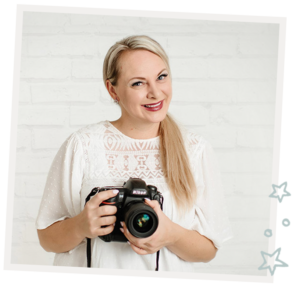
I'm
Lisa DiGeso
I’m on a mission to create uplifting online experiences for photographers ready to elevate their art, their business and their mindset.(...and have fun along the way!)

